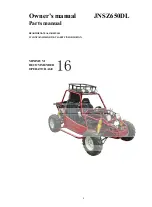
16
Excessive loads and/or underinflation cause tire overloading and, as a result, abnormal tire flexing occurs. This situation
can generate an excessive amount of heat within the tire. Excessive heat may lead to tire failure. It is the air pressure that
enables a tire to support the load, so proper inflation is critical. The proper air pressure may be found on the
certification/VIN label and/or on the Tire Placard. This value should never exceed the maximum cold inflation pressure
stamped on the tire.
1.1.1. T
RAILERS
10,000
P
OUNDS
GVWR
OR
L
ESS
Tire and Loading Information Placard – Figure 1-1
1.
Locate the statement, “The weight of cargo should
never exceed XXX kg or XXX lbs.,” on your vehicle’s
placard. See figure 1-1.
2. This figure equals the available amount of cargo and luggage load capacity.
3. Determine the combined weight of luggage and cargo being loaded on the vehicle. That weight may not
safely exceed the available cargo and luggage load capacity.
The trailer’s placard refers to the Tire Information Placard
attached
adjacent to or near the trailer’s VIN
(Certification) label at the left front of the trailer.
1.1.2. T
RAILERS
O
VER
10,000
P
OUNDS
GVWR
(N
OTE
:
T
HESE TRAILERS ARE NOT REQUIRED TO HAVE A TIRE
INFORMATION PLACARD ON THE VEHICLE
)
1. Determine the empty weight of your trailer by weighing the trailer using a public scale or other means.
This step does not have to be repeated.
2. Locate the
GVWR (Gross Vehicle Weight Rating) of the trailer on your trailer’s VIN (Certification) label.
3. Subtract the empty weight of your trailer from the GVWR stated on the VIN label. That weight is the
maximum available cargo capacity of the trailer and may not be safely exceeded.
1.2. S
TEPS FOR
D
ETERMINING
C
ORRECT
L
OAD
L
IMIT
–
T
OW
V
EHICLE
1.
Locate the statement, “The combined weight of occupants and cargo should never exceed XXX lbs.,” on
your vehicle’s placard.
2. Determine the combined weight of the driver and passengers who will be riding in your vehicle.
3. Subtract the combined weight of the driver and passengers from XXX kilograms or XXX pounds.
4.
The resulting figure equals the available amount of cargo and luggage capacity. For example, if the “XXX”
amount equals 1400 lbs. and there will be five 150 lb. passengers in your vehicle, the amount of available
cargo and luggage capacity is 650 lbs. (1400-750 (5 x 150) = 650 lbs.).
5. Determine the combined weight of luggage and cargo being loaded on the vehicle. That weight may not
safely exceed the available cargo and luggage capacity calculated in Step # 4.
6. If your vehicle will be towing a trailer, load from your trailer will be transferred to your vehicle. Consult the
tow vehicle’s manual to determine how this weight transfer r
educes the available cargo and luggage
capacity of your vehicle.
1.3. G
LOSSARY
O
F
T
IRE
T
ERMINOLOGY
Accessory weight
The combined weight (in excess of those standard items which may be replaced) of automatic transmission,
power steering, power brakes, power windows, power seats, radio and heater, to the extent that these items
are available as factory-installed equipment (whether installed or not).
Tire Safety Information
















































